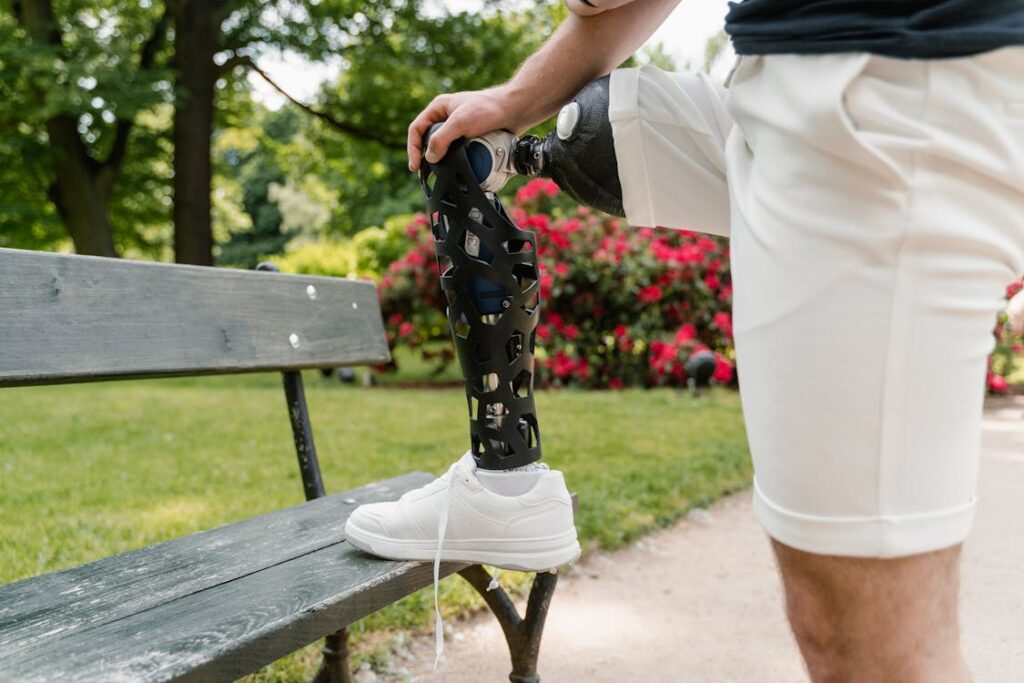Walking is something most of us take for granted. We don’t think about how each foot moves, how much pressure we put down, or how we keep our balance. But for someone using a prosthetic leg, every step is a careful calculation. The body and the prosthetic need to work together in perfect harmony to create a natural, smooth walk — what experts call “gait.”
In the past, prosthetic legs were simple mechanical devices. They helped a person stand or move, but the walk often looked stiff, slow, and tiring. Today, things are different. Thanks to smart sensors, bionic legs are learning how to walk almost like a natural limb. Sensors pick up signals from the body and the environment and help the leg adjust in real-time. The result is a more natural, confident, and easy walk.
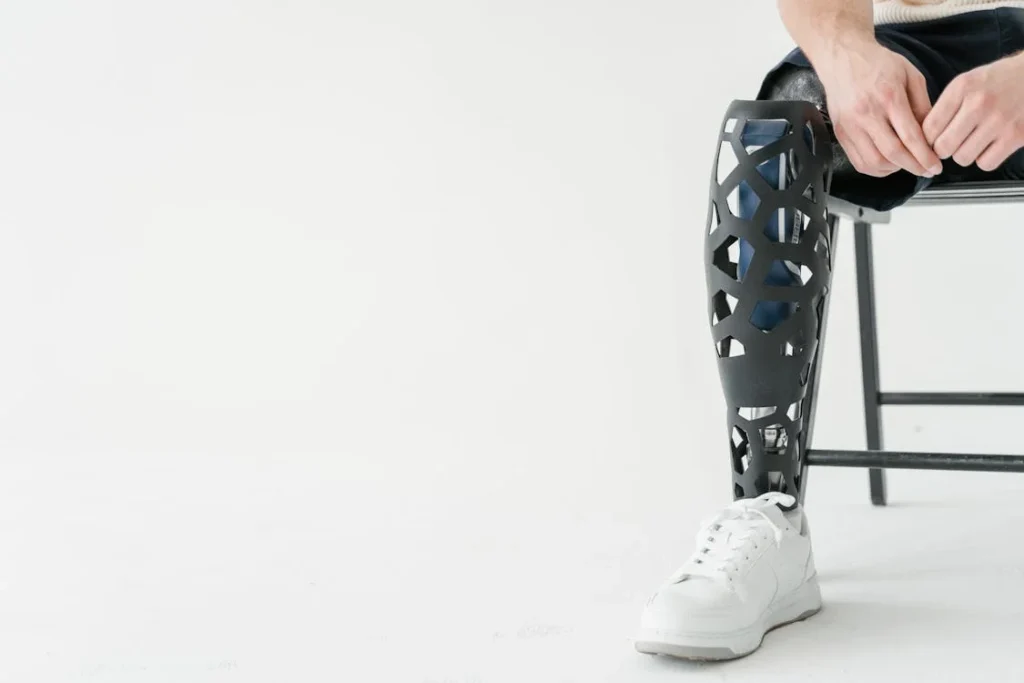
The Role of Smart Sensors in Bionic Legs
Understanding the Basics
Smart sensors are tiny devices that can feel things like pressure, speed, angle, and position. They collect information from the body and the ground, and they send it to a computer inside the prosthetic leg.
This computer, often called a microprocessor, uses that information to decide how the leg should move at every moment.
Imagine walking on a flat surface and then suddenly stepping onto a ramp. Your natural leg instantly knows to adjust the ankle and bend the knee a little more.
Smart sensors allow bionic legs to do the same thing. Without them, the leg would continue moving in the same stiff way, which could lead to falls or discomfort.
At Robobionics, we design prosthetic legs that are always listening to what the body and the ground are telling them. This constant feedback makes every movement smoother and safer.
Different Types of Sensors Used
Not all sensors do the same job. Some are placed near the foot to sense pressure. Others are near the knee to measure bending angles.
A few are even placed in the socket where the limb connects to the prosthetic to read signals from the muscles.
Pressure sensors measure how hard the foot presses on the ground. They help the leg know when to push off and when to relax.
Position sensors, also called gyroscopes and accelerometers, detect the angle of the leg and how fast it is moving. Muscle sensors, called myoelectric sensors, listen to the tiny signals from the muscles that used to control the missing limb.
Each sensor adds a piece to the full picture of how the leg should move at any second. It’s like an orchestra where every instrument plays a small part to create a beautiful song.
How Sensors Improve the Gait
The main goal of using smart sensors in prosthetics is to create a natural, fluid gait. In simple words, it should look and feel like a normal walk. Sensors help achieve this by allowing the leg to:
- Adjust to different surfaces, like grass, sand, or stairs
- Match the user’s walking speed automatically
- Maintain better balance, even when standing still
- Reduce the amount of energy the user needs to walk
- Prevent trips and falls by detecting sudden changes quickly
Without sensors, every small change would require the user to think and manually adjust how they move. With sensors, the leg takes care of the hard work.
It reads the situation and responds instantly, letting the user walk with much less effort.
At Robobionics, we focus on making these adjustments feel as natural as possible. Our bionic legs are designed to learn the user’s walking style during training.
Over time, they adapt even better, offering a truly personal walking experience.

How Smart Sensors Collect and Use Real-Time Data
Constant Communication at Every Step
When someone walks using a bionic prosthetic leg with smart sensors, the experience is not static. It’s alive. At every moment, dozens of tiny measurements are happening inside the leg.
These measurements are taken many times per second, far faster than any human could think or react. The sensors are picking up information about pressure, speed, rotation, and even subtle shifts in weight.
This real-time data moves instantly to a small but powerful computer inside the prosthetic. It’s not like the old days when a leg would just swing forward and back without any adjustments.
Now, the leg thinks about what it needs to do before the user even fully realizes it. For instance, if the user leans forward to take a bigger step, the sensors catch that change immediately. The leg adjusts its swing to match the body’s new intention.
Real-time data allows the leg to be flexible. It makes it possible for users to walk faster when needed, slow down gently, or even come to a full stop naturally, without awkward jerking or locking up.
Instead of being an artificial device attached to the body, the prosthetic becomes a true extension of the person.
Learning Over Time
One of the most exciting things about modern bionic prosthetics is their ability to learn. When someone first receives a new smart prosthetic leg, it may feel unfamiliar.
But over days and weeks of use, the sensors and computer software start building a memory of the user’s movements.
The prosthetic begins to recognize small habits, like how high the user lifts their knee when climbing stairs, or how much weight they place on the toe when pushing off the ground.
Using this memory, the leg fine-tunes its responses. The more the person walks, the more tailored the experience becomes.
At Robobionics, we make sure that this learning process is as smooth as possible. Our devices are programmed to gently guide the user through different types of walking situations during training.
The more varied the practice, the smarter and more helpful the prosthetic becomes.
This ability to learn is incredibly important because no two users walk exactly the same way. Age, strength, limb length, and personal habits all make each walk unique.
By using real-time data and smart learning systems, the prosthetic becomes a partner that fits the user’s life perfectly, not a rigid tool that forces the user to adapt.
Reacting to the Environment Instantly
Walking indoors on a flat floor is one thing. Walking outside on uneven sidewalks, gravel, wet grass, or steep hills is completely different.
Without the right adjustments, these situations could become dangerous very quickly for someone using a prosthetic.
Smart sensors give bionic legs the power to feel the environment. When a person steps on a soft surface like sand, the pressure sensors recognize that the ground gives way a little.
The microprocessor then commands the leg to adjust, often by stiffening slightly or altering the timing of the next step. If a gust of wind pushes the user sideways, the sensors feel the unexpected change in weight distribution and help the user stay balanced.
This quick reaction happens without the user even thinking about it. It brings an enormous boost in confidence, allowing people to walk wherever they want without fear of falling or struggling to adjust.
At Robobionics, we constantly hear stories from users who are amazed the first time they realize their new leg adjusted automatically to something unexpected. It’s a small moment that makes a big difference — one that signals the beginning of walking freely again.
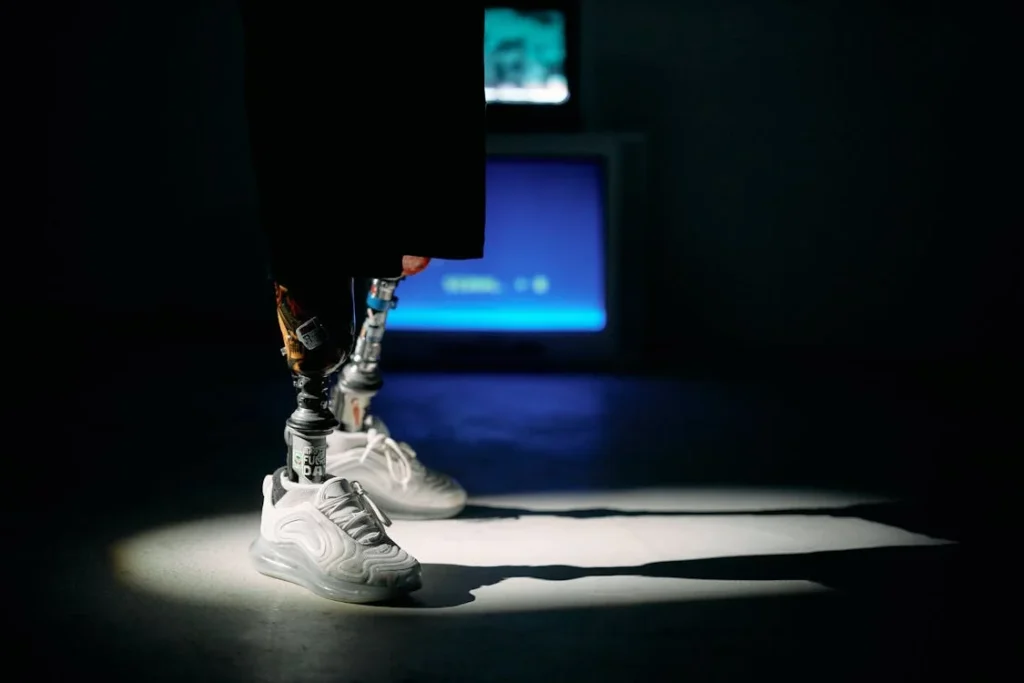
The Power of Combining Smart Sensors with Artificial Intelligence
The Brain Behind the Movement
While smart sensors are essential for gathering information, they are only one part of the magic. To truly transform the walking experience, the data collected by sensors needs to be understood and acted upon immediately. This is where artificial intelligence, or AI, comes in.
Think of AI as the brain inside the prosthetic leg. The sensors are like the eyes, ears, and skin, feeling everything that is happening. But without a brain, those feelings would just be empty signals.
AI takes the millions of bits of information coming in from the sensors and makes quick, smart decisions about how the leg should move.
For example, if a user is walking faster because they are late for a meeting, the AI inside the prosthetic recognizes the change in rhythm and stride length. It tells the joints to move faster and with a slightly different angle to match the new speed.
This happens so smoothly that the user hardly notices it. They simply walk the way they want, and the prosthetic follows.
At Robobionics, we work hard to develop AI systems that are not only fast but also safe and reliable. We know that real life is full of surprises, and we design our AI to handle them gracefully.
Personalizing the Prosthetic to Each User
One of the most powerful aspects of combining sensors and AI is the ability to make every prosthetic leg unique. In the past, prosthetics were built with a one-size-fits-all mindset.
There was little room for personal comfort or walking style. But today, AI makes personalization possible.
During the first days and weeks of wearing a new bionic leg, the AI system observes how the user moves. It watches how they stand up, how they climb stairs, how they turn corners, and how they walk slowly or quickly. Over time, the AI builds a detailed model of that person’s movements.
This model is like a fingerprint — no two are exactly alike. Based on this personalized model, the prosthetic learns to anticipate what the user is about to do and adjusts in advance.
It’s a little like walking with a smart friend who knows you so well they can predict your next step.
Robobionics believes that true freedom comes from feeling natural, not mechanical. That’s why we make sure our prosthetics are built to learn, adapt, and grow with each user’s unique needs and lifestyle.
Adapting to Changes Over Time
Life is not static. A person’s strength, weight, habits, and environment can all change over time. Without AI, a prosthetic leg would struggle to keep up with these changes.
But with smart sensors and AI working together, the prosthetic can adapt naturally.
If a user becomes stronger and starts walking more briskly after months of rehabilitation, the AI adjusts the timing and force of each step. If the user moves to a city with lots of hills and uneven paths, the AI can quickly learn the new demands and modify the walking strategy accordingly.
This ability to adapt is what sets today’s bionic legs apart from the older generations. It also removes a lot of the mental burden from the user.
They don’t have to constantly think about their prosthetic or worry if it can handle new challenges. They can simply live their lives, trusting that their leg is smart enough to keep up.
At Robobionics, we see AI not just as a tool but as a companion. A well-designed AI doesn’t replace the user’s efforts; it supports and enhances them, creating a partnership between person and prosthetic that is both empowering and life-changing.
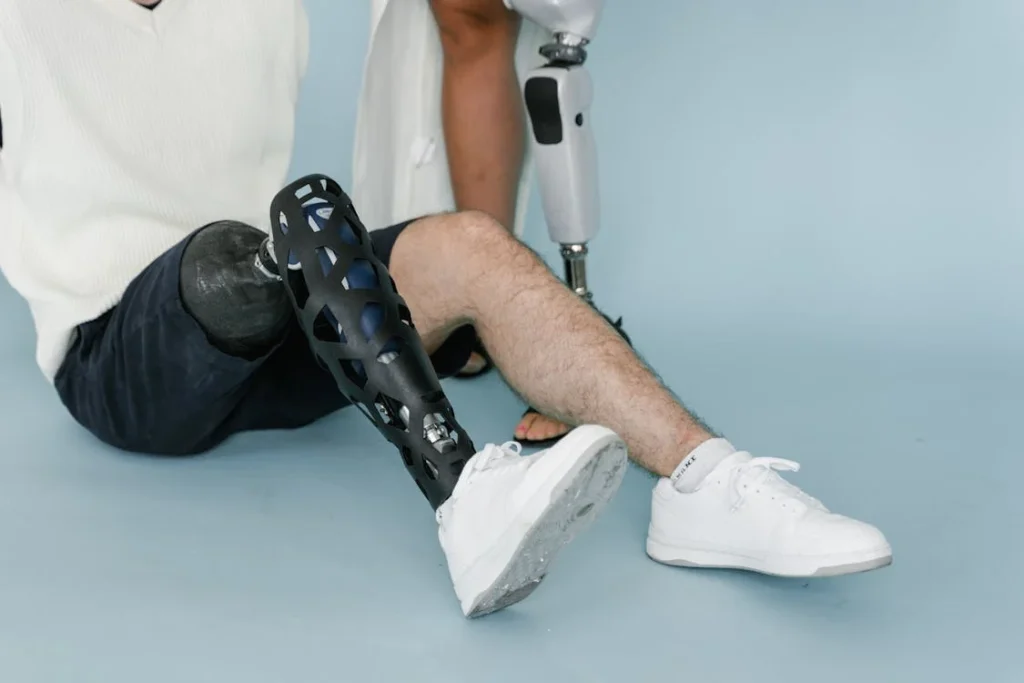
Real-World Stories: How Smart Sensors Are Changing Lives
Walking with Confidence Again
For many people who lose a leg, one of the hardest parts is regaining the confidence to move freely. It’s not just about standing up and taking steps. It’s about trusting that every move will be safe, steady, and natural.
One of our users at Robobionics, a young teacher from Pune, struggled with uneven surfaces in her school’s playground. With her older mechanical prosthetic, she had to carefully plan each step and often avoided outdoor activities altogether.
After switching to a bionic leg equipped with smart sensors and adaptive AI, she felt a difference immediately. Her new leg sensed the shifting ground, adjusted the pressure, and maintained her balance without her even thinking about it.
Within weeks, she was confidently walking around the playground with her students, something she hadn’t imagined doing before.
Stories like hers remind us that the real power of smart sensors isn’t just technical — it’s deeply personal. It’s about giving people back a part of their lives that they thought was lost forever.
Returning to Active Lifestyles
A prosthetic leg with smart sensors doesn’t just help with normal walking. It can also open the door to more active lifestyles. One of our users, a former athlete from Chennai, was passionate about hiking but had to give it up after losing his limb.
Hiking trails are unpredictable, with rocks, slopes, and uneven surfaces that can be dangerous for anyone, let alone someone using a prosthetic.
After receiving his smart bionic leg, which constantly monitors terrain and adjusts every step, he decided to try hiking again. It wasn’t easy at first, but with time and training, he regained his rhythm.
The leg’s sensors detected when he was going uphill and downhill, changing the stiffness and angle of the knee automatically to match the slope. The AI kept learning from his movements, helping him hike longer distances each week. Now, he’s back to exploring nature, one trail at a time.
These kinds of experiences show that smart sensor technology is not just about basic mobility. It’s about restoring passions, hobbies, and dreams.
Making Daily Life Easier
Not everyone dreams of hiking mountains or running marathons. For many, success is simply being able to move around their home, go shopping, or take a walk in the park without fear.
For an elderly woman from Kolkata, simple tasks like walking to the nearby market had become overwhelming after losing her leg.
With her new bionic prosthetic fitted with real-time sensors, she noticed the difference the very first day. The leg sensed changes in walking speed, helped her stay balanced when stepping off curbs, and adapted its support when she carried groceries.
Even when she walked slower or faster depending on the crowd, the prosthetic adjusted without her needing to think about it.
Over time, daily life stopped feeling like an obstacle course. It started feeling normal again. She could focus on her errands, her friends, and her family, instead of worrying about each step.
At Robobionics, these everyday victories are what drive us. Seeing a smile after a confident walk or hearing about a small triumph fills us with pride and reminds us why technology needs to be human-centered.
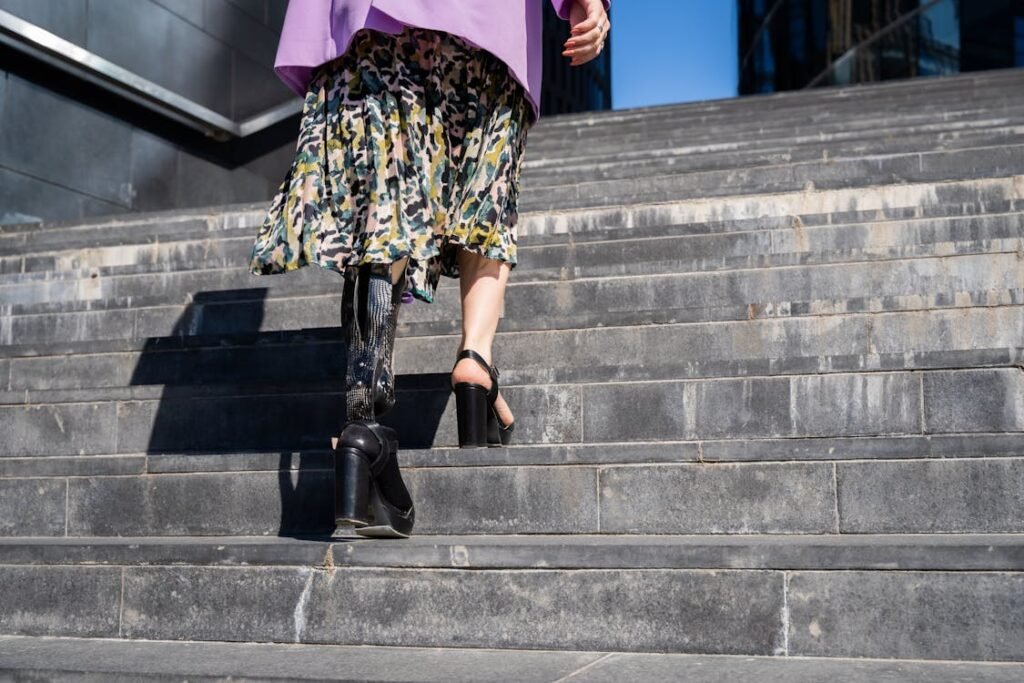
The Challenges of Designing Smart Sensor Systems for Prosthetics
Balancing Sensitivity and Stability
Creating smart prosthetic legs that work seamlessly in real life is not as simple as attaching a few sensors. One of the biggest challenges engineers face is finding the perfect balance between sensitivity and stability.
If the sensors are too sensitive, the leg might react to every tiny movement, even ones that don’t need a response. This could make the prosthetic feel jittery or unstable.
On the other hand, if the sensors are not sensitive enough, the leg might miss important signals, leading to delayed or stiff movements.
At Robobionics, our engineers work tirelessly to fine-tune the way sensors pick up information. They make sure the prosthetic listens carefully but responds only when it truly needs to.
This careful balance is what allows users to move smoothly without feeling like they are being dragged by their prosthetic or fighting against it.
Handling Different Environments
Real life doesn’t happen on a smooth treadmill. People walk on cracked sidewalks, muddy paths, slippery floors, and steep hills. Each environment poses its own challenges for a bionic leg.
Sensors need to recognize not only the current surface but also predict how it might change with each step.
For example, a surface might seem stable but suddenly shift, like loose gravel or wet tiles. If the prosthetic doesn’t detect and adjust quickly enough, it can cause a fall.
Designing sensors that can understand and react to these quick changes is extremely complex.
Robobionics engineers spend a lot of time testing prosthetic legs in real-world environments, not just in labs.
We believe that no amount of indoor testing can replace the lessons learned from walking through a crowded market, crossing a muddy field, or stepping onto a slick marble floor during monsoon season.
Power Management and Battery Life
All of this real-time sensing and fast adjustment requires power. Smart prosthetics rely on small batteries to run their computers and sensors.
One challenge engineers face is making sure that all of this technology can work all day without the user worrying about running out of battery.
Bigger batteries can store more energy, but they add weight, which can make the prosthetic uncomfortable or tiring to use. Smaller batteries are lighter but may not last long enough.
Finding the right balance between power, weight, and runtime is a constant puzzle.
At Robobionics, we design our systems to be energy-efficient. Our smart sensors and AI are programmed to work hard only when needed and to rest when possible, saving battery life without losing performance.
This means users can trust their prosthetic to keep up with them throughout a busy day without constantly checking the battery level.
Keeping the Technology User-Friendly
Another major challenge is making the prosthetic easy to use. A bionic leg could have the most advanced sensors and smartest AI in the world, but if it feels complicated or overwhelming, it won’t serve the user well.
Our goal is to make the experience feel natural. Users should not need to think about calibrating sensors or adjusting settings. The prosthetic should simply adapt to them, quietly and automatically.
This philosophy shapes every design choice we make at Robobionics, from the first sketch on paper to the final product fitted onto a real person.
It’s not enough for technology to be smart. It has to be kind to the people who rely on it every day.

The Future of Smart Sensors in Bionic Prosthetic Legs
Smarter, Faster, and More Intuitive
The journey of smart prosthetics is far from over. In fact, we are only at the beginning. As technology continues to grow, smart sensors are becoming even smaller, faster, and more powerful.
This means future bionic legs will be able to gather even more detailed information about the user and the environment. They will process it instantly, making movements even smoother and more natural than today.
At Robobionics, we are investing heavily in the next generation of sensor technology. Our aim is to create prosthetics that feel less like machines and more like a true part of the body.
Future sensors will be able to predict movements before they even fully happen, based on tiny shifts in body weight, muscle activity, and intention. This kind of predictive ability will make walking with a prosthetic feel nearly identical to walking with a natural leg.
Deeper Integration with the Human Body
One of the most exciting directions for the future is deeper integration between prosthetics and the human nervous system. Today, many prosthetic legs rely on external sensors placed in the socket or on the skin.
But researchers, including our teams at Robobionics, are working on ways to connect prosthetics more closely with the muscles and nerves themselves.
This could mean using tiny implants that pick up nerve signals directly from the residual limb. It could also involve advanced muscle sensors that recognize not just basic movements but also subtle emotions like tension, relaxation, and readiness to run.
Imagine a prosthetic that can feel when you are about to sprint or when you are getting tired, and adjust instantly to support you better.
While these technologies are still being developed, they hold incredible promise. They bring us closer to a world where prosthetics do not just respond to the body but become an extension of it in every sense.
Personalized AI That Grows With You
Artificial intelligence inside prosthetics is already impressive, but the future holds even more promise. We believe that tomorrow’s prosthetics will feature AI that evolves with the user over years, not just months.
It will learn from every experience — every walk on the beach, every hike up a hill, every rush through a crowded street — and constantly refine itself to serve the user better.
This means that a prosthetic received at age 25 could still feel perfectly tuned at age 45, adapting naturally to changes in strength, balance, and lifestyle.
It would be like having a personal coach and walking partner, one that never gets tired of learning how to support you better.
At Robobionics, we are working toward this future by building AI systems that can be updated remotely, improved through software without the need to replace the entire prosthetic. This makes the investment in a smart prosthetic even more valuable over time.
A More Inclusive and Accessible Future
As technology advances, another goal becomes clear: making these powerful tools available to more people. Today, smart bionic legs are still expensive and not as widely accessible as they should be.
At Robobionics, our mission is to change that by focusing on local manufacturing, affordable designs, and faster service support right here in India.
We believe that everyone, no matter where they live or how much they earn, deserves access to the best technology to regain their independence and confidence.
The future of smart sensors in prosthetics is not just about better machines. It is about better lives — lives lived with freedom, dignity, and endless possibilities.
Conclusion
Smart sensors have transformed bionic prosthetic legs from simple walking aids into intelligent partners that move naturally with the body. By working hand-in-hand with artificial intelligence, these sensors make every step smoother, safer, and more personal. They restore not just mobility, but confidence, independence, and a true sense of freedom.
At Robobionics, we are proud to be part of this revolution. Our commitment is to keep pushing boundaries, creating prosthetics that adapt, learn, and empower every user. As technology grows, so does the potential for better lives — lives filled with movement, purpose, and dignity.
The future is bright, and every step we take brings us closer to a world where prosthetics are not just replacements, but true extensions of the human spirit.



